Coral bleachings devastate Bali reefs as sea temperatures rise

Fish swim near recovering coral reefs after bleaching in late December 2023 due to extreme weather, in Bondalem village, Buleleng regency, Bali, Indonesia, June 20, 2024.

Fish swim near recovering coral reefs after bleaching in late December 2023 due to extreme weather, in Bondalem village, Buleleng regency, Bali, Indonesia, June 20, 2024.
PUBLISHED JULY 05, 2024
BONDALEM, Indonesia — Indonesian conservationist Nyoman Sugiarto has been working for 16 years to preserve coral on the reefs of Bali, but the frequency of mass coral bleachings he says is now devastating.
Ninety per cent of the corals Sugiarto had nurtured on the reefs near his village in Bondalem, in northern shore of Bali, lost their colour last December.
"It was all white. We were shocked and of course, it also negatively affected the coral we planted. It's not just the natural ones," 51-year-old Sugiarto told Reuters.
When Sugiarto began coral conservation projects in 2008 he was told that coral could retain the living algae which gives it colour for 10 to 20 years.
Yet, the coral reefs off Bondalem were bleached in less than 10 years, he says, blaming warmer sea temperatures triggered by climate change.
Coral bleaching occurs when coral expels the colourful algae living in its tissues. Without the algae the coral becomes pale and vulnerable to starvation, disease or death.
In April, the US National Oceanic and Atmospheric Administration (NOAA) said more than 54 per cent of the reef areas in the world's oceans are experiencing bleaching-level heat stress, the fourth global bleaching event in the last three decades.
Indonesia has roughly 5.1 million hectares of coral reefs and accounts for 18 per cent of the world's total, data from the country's tourism ministry showed.
Coral bleaching in Bali in late 2023 was mainly caused by rising sea temperatures caused by the El Nino phenomenon that hit Indonesia, said Marthen Welly, a marine conservation adviser at the Coral Triangle Centre.
Indonesia experienced the most severe dry season last year since 2019 due to the El Nino.
While Indonesia's corals are more resilient and tend to recover faster, Marthen said it will not be enough to withstand the rising ocean temperature.
"It's predicted that the coral bleaching will occur more often, between one or two years with the current temperature," he said, quoting the latest research by the Great Barrier Reef Marine Park Authority and the Australian Institute of Marine Science.
However, Sugiarto says he is determined to continue his campaign to conserve corals, and is advocating coral conservation to younger Indonesians and seeking funds to establish a village community to monitor illegal fishing.
"We feel that we have the obligation to guard the sustainability of underwater life especially corals," he said.
BONDALEM, Indonesia — Indonesian conservationist Nyoman Sugiarto has been working for 16 years to preserve coral on the reefs of Bali, but the frequency of mass coral bleachings he says is now devastating.
Ninety per cent of the corals Sugiarto had nurtured on the reefs near his village in Bondalem, in northern shore of Bali, lost their colour last December.
"It was all white. We were shocked and of course, it also negatively affected the coral we planted. It's not just the natural ones," 51-year-old Sugiarto told Reuters.
When Sugiarto began coral conservation projects in 2008 he was told that coral could retain the living algae which gives it colour for 10 to 20 years.
Yet, the coral reefs off Bondalem were bleached in less than 10 years, he says, blaming warmer sea temperatures triggered by climate change.
Coral bleaching occurs when coral expels the colourful algae living in its tissues. Without the algae the coral becomes pale and vulnerable to starvation, disease or death.
In April, the US National Oceanic and Atmospheric Administration (NOAA) said more than 54 per cent of the reef areas in the world's oceans are experiencing bleaching-level heat stress, the fourth global bleaching event in the last three decades.
Indonesia has roughly 5.1 million hectares of coral reefs and accounts for 18 per cent of the world's total, data from the country's tourism ministry showed.
Coral bleaching in Bali in late 2023 was mainly caused by rising sea temperatures caused by the El Nino phenomenon that hit Indonesia, said Marthen Welly, a marine conservation adviser at the Coral Triangle Centre.
Indonesia experienced the most severe dry season last year since 2019 due to the El Nino.
While Indonesia's corals are more resilient and tend to recover faster, Marthen said it will not be enough to withstand the rising ocean temperature.
"It's predicted that the coral bleaching will occur more often, between one or two years with the current temperature," he said, quoting the latest research by the Great Barrier Reef Marine Park Authority and the Australian Institute of Marine Science.
However, Sugiarto says he is determined to continue his campaign to conserve corals, and is advocating coral conservation to younger Indonesians and seeking funds to establish a village community to monitor illegal fishing.
"We feel that we have the obligation to guard the sustainability of underwater life especially corals," he said.
July 06, 2024
By Agence France-Presse
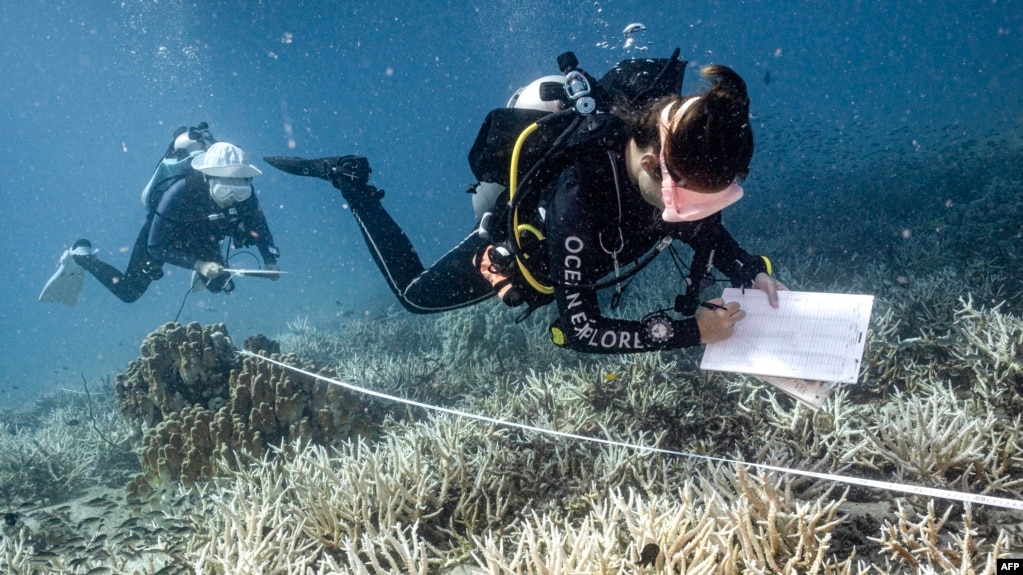
This underwater photo taken on June 14, 2024 shows Black Turtle Dive conservation teacher Sandra Rubio (R) and her student Nannalin "Fleur" Pornprasertsom (L) surveying bleached corals around Koh Tao island in the southern Thai province of Surat Thani.
KOH TAO, THAILAND —
A diver glides over an expanse of bone-white coral branches, recording the fish that dart between the ghostly arms extending from the sea floor off the Thai island of Koh Tao.
Nannalin Pornprasertsom is one of a growing number of scuba divers learning conservation and citizen science techniques as coral reefs experience a fourth global bleaching event.
After a two-week course in Koh Tao, the 14-year-old can identify coral types, carry out reef restoration, and help scientific research on coral health by recording the color and tone of outcroppings at dive sites.
"It's just something that I can do that will have a good consequence for the environment," Nannalin, who has been diving since she was 12, told AFP after a series of dives.
"I want to help the reef."
And she is not alone.
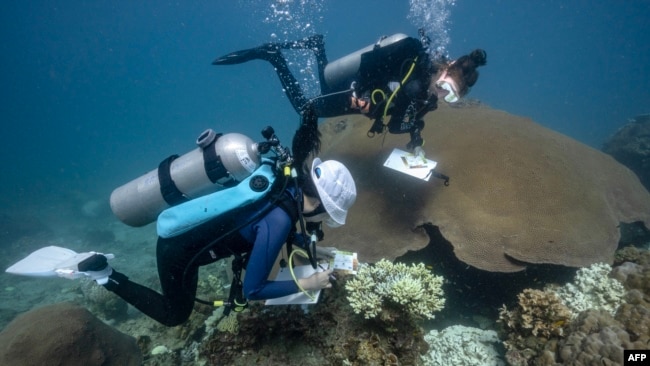
KOH TAO, THAILAND —
A diver glides over an expanse of bone-white coral branches, recording the fish that dart between the ghostly arms extending from the sea floor off the Thai island of Koh Tao.
Nannalin Pornprasertsom is one of a growing number of scuba divers learning conservation and citizen science techniques as coral reefs experience a fourth global bleaching event.
After a two-week course in Koh Tao, the 14-year-old can identify coral types, carry out reef restoration, and help scientific research on coral health by recording the color and tone of outcroppings at dive sites.
"It's just something that I can do that will have a good consequence for the environment," Nannalin, who has been diving since she was 12, told AFP after a series of dives.
"I want to help the reef."
And she is not alone.

This underwater photo taken on June 14, 2024 shows Black Turtle Dive conservation teacher Sandra Rubio (R) and her student Nannalin "Fleur" Pornprasertsom (L) conducting a coral survey around Koh Tao island in the southern Thai province of Surat Thani.
The Professional Association of Diving Instructors -- better known as PADI, one of the world's leading dive training organizations -- says conservation certifications jumped over six percent globally from 2021-2023.
This year, it is launching a major shark and ray census, harnessing its network of divers to collect data that will shape protection policies.
On Koh Tao, Black Turtle Dive offers courses on everything from how to properly "dive against debris" -- collecting marine plastic or stranded fishing nets -- to coral restoration techniques.
"There's an increased awareness," said Steve Minks, a certified conservation instructor at Black Turtle.
"There's a lot of bleaching going on and there's a lot of concern about the marine environment."
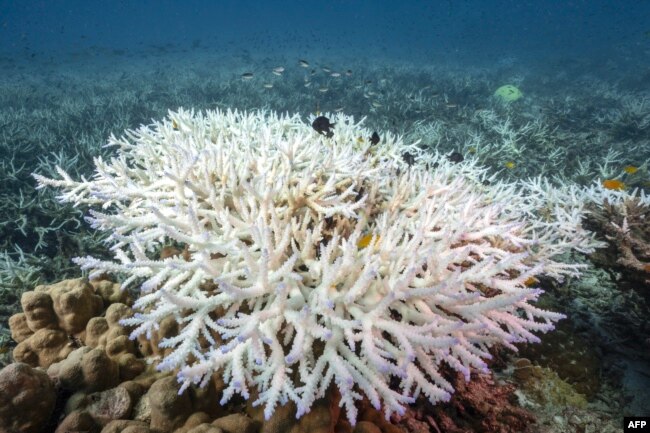
The Professional Association of Diving Instructors -- better known as PADI, one of the world's leading dive training organizations -- says conservation certifications jumped over six percent globally from 2021-2023.
This year, it is launching a major shark and ray census, harnessing its network of divers to collect data that will shape protection policies.
On Koh Tao, Black Turtle Dive offers courses on everything from how to properly "dive against debris" -- collecting marine plastic or stranded fishing nets -- to coral restoration techniques.
"There's an increased awareness," said Steve Minks, a certified conservation instructor at Black Turtle.
"There's a lot of bleaching going on and there's a lot of concern about the marine environment."

This underwater photo taken on June 14, 2024 shows bleached corals around Koh Tao island in the southern Thai province of Surat Thani.
Death spiral
Coral polyps are animals that depend on algae to provide most of their food. These algae also generally give the reef its color.
But when the sea is too warm, the polyps expel the algae. The reef turns white and the coral begins to starve.
Coral bleaching has been recorded in more than 60 countries since early 2023, threatening reefs that are key to ocean biodiversity and support fishing and tourism globally.
The death spiral is everywhere in the waters of the Gulf of Thailand around Koh Tao.
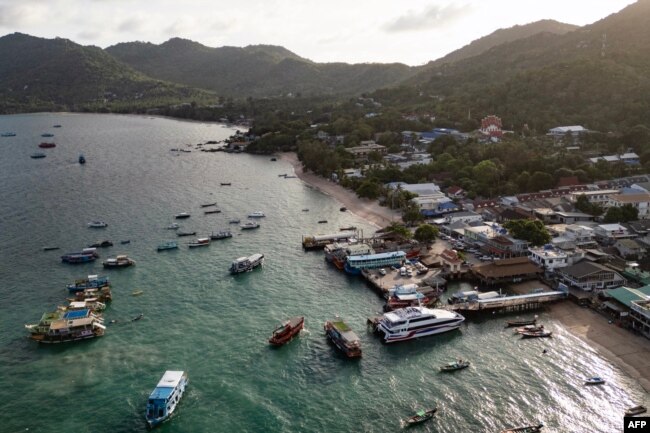
Death spiral
Coral polyps are animals that depend on algae to provide most of their food. These algae also generally give the reef its color.
But when the sea is too warm, the polyps expel the algae. The reef turns white and the coral begins to starve.
Coral bleaching has been recorded in more than 60 countries since early 2023, threatening reefs that are key to ocean biodiversity and support fishing and tourism globally.
The death spiral is everywhere in the waters of the Gulf of Thailand around Koh Tao.

This aerial photo taken on June 15, 2024 shows Mae Head pier on Koh Tao island in the southern Thai province of Surat Thani.
Worst affected are branching species that grow quickly, but are also less resilient.
If water temperatures come down, they will have a chance at recovery. But for now, their spectral stems are even visible from the surface, glimmering through the aquamarine water.
"I was not ready for that much bleaching, it's quite an impact," admits instructor Sandra Rubio.

Worst affected are branching species that grow quickly, but are also less resilient.
If water temperatures come down, they will have a chance at recovery. But for now, their spectral stems are even visible from the surface, glimmering through the aquamarine water.
"I was not ready for that much bleaching, it's quite an impact," admits instructor Sandra Rubio.

This photo taken on June 14, 2024 shows Black Turtle Dive conservation teacher Sandra Rubio (L) teaching coral conservation to her students in the Black Turtle Dive classroom in Koh Tao island in the southern Thai province of Surat Thani.
The 28-year-old says bleaching and other marine degradation are driving divers to take her conservation courses.
"People want to start learning because they see these kinds of changes," she told AFP.
"And even if they don't really understand why, they know it's not good."
She walks students through how to identify species, including soft coral. Wave at it, she explains, mimicking wiggling a hand in the water, and wait to see if it "waves back."
The skills taught at Black Turtle and other dive shops are not simply theoretical.
Artificial coral reefs are dotted around Koh Tao, actively rebuilding marine habitats.
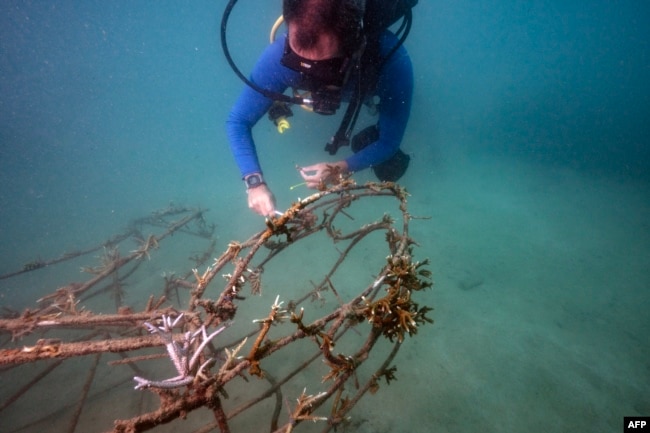
The 28-year-old says bleaching and other marine degradation are driving divers to take her conservation courses.
"People want to start learning because they see these kinds of changes," she told AFP.
"And even if they don't really understand why, they know it's not good."
She walks students through how to identify species, including soft coral. Wave at it, she explains, mimicking wiggling a hand in the water, and wait to see if it "waves back."
The skills taught at Black Turtle and other dive shops are not simply theoretical.
Artificial coral reefs are dotted around Koh Tao, actively rebuilding marine habitats.

This underwater photo shows Gavin Miller, the scientific program director from marine research center Global Reef, cleaning an artificial structure for coral planting around Koh Tao island in the southern Thai province of Surat Thani, June 16, 2024.
And Nannalin's data on coral health is part of Coral Watch -- a global citizen science project that has produced numerous research papers.
"What we're doing is collecting data for scientists so they can actually work with governments and authorities," explained Minks.
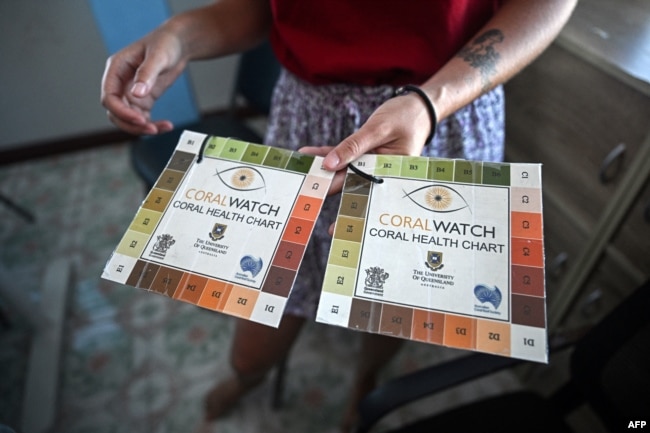
And Nannalin's data on coral health is part of Coral Watch -- a global citizen science project that has produced numerous research papers.
"What we're doing is collecting data for scientists so they can actually work with governments and authorities," explained Minks.

Black Turtle Dive conservation teacher Sandra Rubio holds a coral health chart used by citizen scientists to track the health of corals, in the Black Turtle Dive classroom in Koh Tao island in the southern Thai province of Surat Thani, June 14, 2024.
'Doing our best'
On a sunny afternoon on Koh Tao, a boat carries a starfish-shaped rebar structure designed by schoolchildren out to sea, where it will become Global Reef's latest coral restoration project.
Since it was founded two years ago, Global Reef has transplanted around 2,000 coral colonies, with a survival rate of about 75 percent, said Gavin Miller, the group's scientific program director.
"It's not really going to maybe save coral reefs globally... but what it does do is have a very, very large impact locally," he said.
"We have snappers returning. We have resident puffer fish."
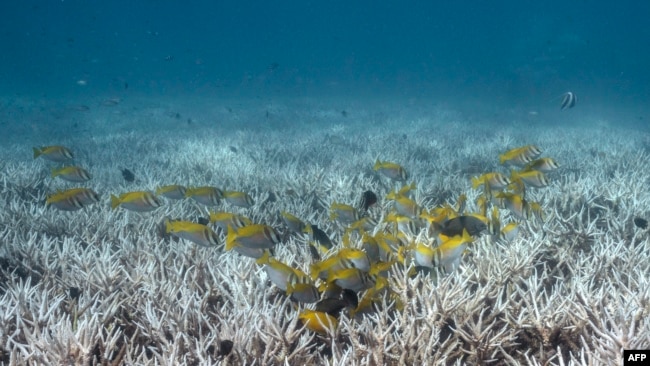
'Doing our best'
On a sunny afternoon on Koh Tao, a boat carries a starfish-shaped rebar structure designed by schoolchildren out to sea, where it will become Global Reef's latest coral restoration project.
Since it was founded two years ago, Global Reef has transplanted around 2,000 coral colonies, with a survival rate of about 75 percent, said Gavin Miller, the group's scientific program director.
"It's not really going to maybe save coral reefs globally... but what it does do is have a very, very large impact locally," he said.
"We have snappers returning. We have resident puffer fish."

This underwater photo taken on June 14, 2024 shows fish swimming over bleached corals around Koh Tao island in the southern Thai province of Surat Thani.
Global Reef also hosts interns who are training artificial intelligence programs to identify fish in 360-degree videos for reef health surveys, and collaborates regularly with the dive school next door.
And they are studying the surprising resilience of some local coral to persistently high temperatures.
"These might be sort of refuges for coral," explained Miller.
This year's bleaching has left many marine enthusiasts despondent, but for conservation divers on Koh Tao, it is also a call to arms.
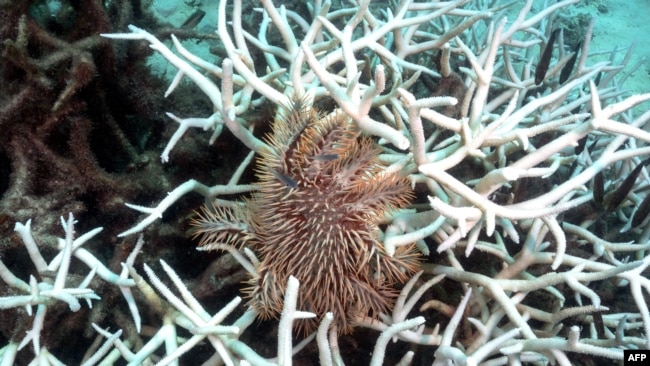
Global Reef also hosts interns who are training artificial intelligence programs to identify fish in 360-degree videos for reef health surveys, and collaborates regularly with the dive school next door.
And they are studying the surprising resilience of some local coral to persistently high temperatures.
"These might be sort of refuges for coral," explained Miller.
This year's bleaching has left many marine enthusiasts despondent, but for conservation divers on Koh Tao, it is also a call to arms.

This underwater photo taken on June 15, 2024 shows a crown of thorns feeding amongst bleached corals around Koh Tao island in the southern Thai province of Surat Thani.
"In the previous generations, we didn't have this research and education that we have now," said Nannalin.
"I think people my age should make the most of it and try their best to reverse the things that have already been done."
The work also helps Rubio balance the sadness she feels at the changes below the water.
"It's not like we are going to change things from one day to another, but we are doing our best, and that is the best feeling," she said.
"I'm working every day to do something good for the environment and for the reef that I love."
"In the previous generations, we didn't have this research and education that we have now," said Nannalin.
"I think people my age should make the most of it and try their best to reverse the things that have already been done."
The work also helps Rubio balance the sadness she feels at the changes below the water.
"It's not like we are going to change things from one day to another, but we are doing our best, and that is the best feeling," she said.
"I'm working every day to do something good for the environment and for the reef that I love."
No comments:
Post a Comment